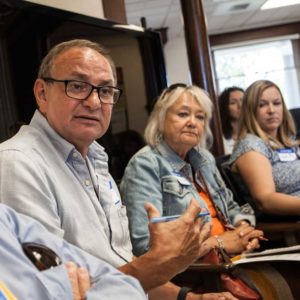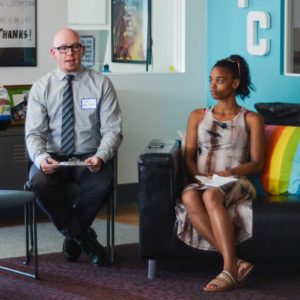If you are like many of us here at A Way Home Washington, you spent July and August soaking up as much of the Rio Olympics as possible. As you were watching, you might have asked yourself, What makes Simone Biles so dominant in gymnastics? Turns out, one reason is that Simone has such a powerful run, she can begin her tumbling passes earlier, giving her more room to flip and twist.
Access to data helps us answer so many questions—not just about our favorite athletes, but also about some of the most urgent issues our society faces. And quality data does more than raise awareness or find answers. It helps point to ways we can better spend our money, focus our time, or allocate resources to save and improve lives.
Think about how you make decisions about the products you buy. You compare reviews, examine the cost and effectiveness of various products, and ask friends about their experiences. With all that data and information combined, you make a well-informed decision for you and your family.
The problem we face here in Washington state is that, for years, we’ve lacked detailed, accurate information about the state of youth homelessness. As a result, thousands of youth are forgotten and left behind. That’s why A Way Home Washington commissioned a landscape analysis of youth homelessness in the state.
The scan focused on five communities: Spokane County, the south sound, Walla Walla County, Yakima County, and a cluster of rural regions across the state. It documented each area’s demographic statistics, available programs for youth, capacity to support and address youth homelessness, and identifiable community needs to expand these programs and services.
Much of the findings are community specific, but there were some common statewide themes:
Youth experiencing homelessness stay local: 86 percent of youth experiencing homelessness access services in the same zip code of their last permanent address.
We must improve social services: 28 percent of youth exiting the foster care system are homeless within 12 months, and that number is 26 percent for youth exiting the juvenile justice system.
Once a young person is housed, they stay that way: Only 2 percent of youth accessing homeless services returned to homelessness from transitional or permanent housing.
It’s clear there’s a lot of work ahead of us to solve youth homelessness, but some of the findings offer encouraging suggestions for how we can approach this work with partners. Several “quick wins”— actions or policy changes that would yield near-immediate, positive results—were identified:
Ensure consistency at school: Make sure students experiencing homelessness keep their Individual Education Plans—developed for each public school child eligible for special education—if they change schools.
Enhance statewide data to inform decision-making: Develop a statewide dashboard to monitor progress against key metrics in youth homelessness, and disaggregate the data by race to ensure that progress is equitable.
Strengthen communication among service providers: Improve communications around licensing for shelters, host homes, and foster care programs, and create relationships between juvenile detention centers and youth housing providers to prevent discharging youth from detention to the streets.
This scan—one of the most complete aggregations of local data to date—makes it clear that while many approaches to ending youth homelessness can and should be tailored to communities. They shouldn’t exist in silos.
There are so many things we still want to learn, though, and that’s why A Way Home Washington is currently on a Listening & Learning Tour across the state. It started August 16, with First Lady Trudi Inslee and Kim Justice, Executive Director of the Washington Office of Homeless Youth, sitting down with youth and community leaders in Yakima. They’ve also stopped in Tacoma, Vancouver, and Everett to learn about common barriers and solutions for ending youth homelessness, and understand what unique challenges exist.
At the conclusion of this tour, we’ll report out what we’ve heard from communities. Combined with the qualitative findings in this scan, we will be able to explore targeted, tailored, and transformational solutions to help end youth homelessness in this state.
If we’re successful, maybe we’ll inspire the next Simone Biles. At the very least, we’ll help the next generation of young people in this state to reach their full potential.

 the expanding crisis of youth and young adult homelessness. Our task now is to ensure every community has the awareness, information and support needed to take action.”
the expanding crisis of youth and young adult homelessness. Our task now is to ensure every community has the awareness, information and support needed to take action.” services from
services from